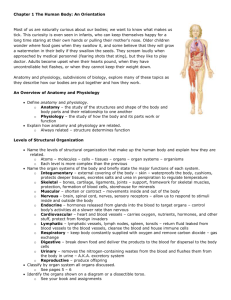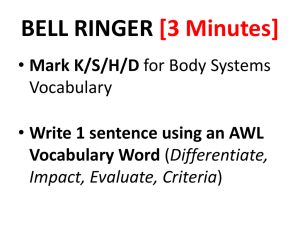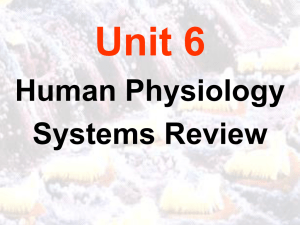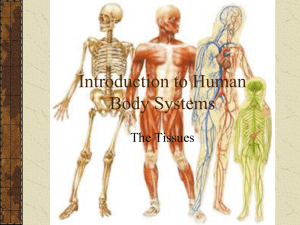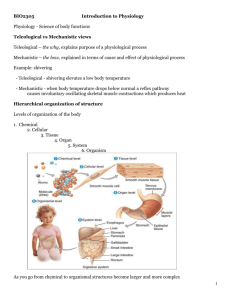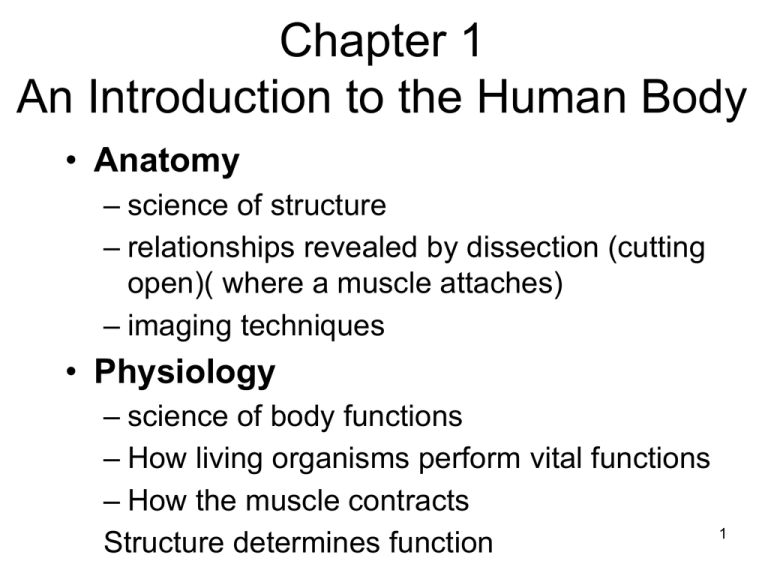
Chapter 1
An Introduction to the Human Body
• Anatomy
– science of structure
– relationships revealed by dissection (cutting
open)( where a muscle attaches)
– imaging techniques
• Physiology
– science of body functions
– How living organisms perform vital functions
– How the muscle contracts
1
Structure determines function
Levels of Organization
•
•
•
•
•
•
Chemical
Cellular
Tissue
Organs
System Level
Organismic
Level
Levels of Structural Organization
• Chemical Level
– atomic or molecular level. The smallest stable units of matter.
Even at this level form( 3 dimension shape) determines
function.
• Cellular level
– smallest living unit of the body. Molecules can interact
to form various organelles. ORGANELLES are the
structural and functional component of the cell.
• Tissue level
– group of cells and the materials surrounding them
that work together on one task
– 4 basic tissue types
• epithelium, muscle, connective tissue, and nerve
Levels of Structural Organization
• Organ level
– grouping of 2 or more tissue types into a recognizable
structure with a specific function. Layers of cardiac
tissue in combination with connective tissue form the
wall of the heart, a hollow 3-dimensional organ.
• Organ system
– collection of related organs with a common function
– Each time the heart contracts the heart, blood, blood
vessels form the cardiovascular system. 1 of 11 organ
systems.
• Organismic level- THE HUMAN. All systems must work
together in harmony to maintain life, health & wellness.
The 11 Systems
• The Neural System- The MASTER SYSTEM. Brain,
spinal cord, peripheral nerves, sense organs.
• It coordinates activities of other organ systems.
• It provides and interprets sensory information about
external conditions.
• Directs immediate responses to stimuli
• First system that develops, gives life to all systems.
• Endocrine System- Pituitary gland, thyroid gland,
pancreas, adrenals, testes, ovaries.
• Directs long term changes in systems.
• Adjusts metabolic activity &energy use by they body.
• Control structural / functional changes during
Systems Continued
• Muscular System- Skeletal muscles, fascia and
tendons.
• Provides motion
• Provides protection and support to other tissues
• Generates heat to maintain body temperature
• Skeletal System- Bones, cartilages, ligaments,
bone marrow.
• Provides support and protection for other
tissues
• Stores calcium and minerals
• Forms blood cells
Systems continued
• Cardiovascular- Heart, blood, blood vessels
• Distributes blood cells, water, nutrients, oxygen, carbon
dioxide, and waste products.
• Distributes heat and assists in body temperature.
•
•
•
•
Integumentary- Skin, hair, sweat glands, nails
Protects against environmental hazards.
Regulates body temperature
Provides sensory information
Systems continued
• Lymphatic- Spleen, Thymus, Tonsils, Lymph nodes.
• Defends against infections
• Returns tissue fluid to the blood stream.
• Respiratory- Nasal cavities, Sinuses, Larynx, Trachea,
Bronchi, Lungs, Alveoli.
• Delivers air to alveoli where gas exchange occurs.
• Provides O2 to bloodstream / removes CO2.
• Produces sound for communication.
Systems Continued
• Digestive System- Teeth, tongue, pharynx, esophagus,
Stomach, S.I/ L.I, Liver, Gallbladder, Pancreas.
• Processes and digests food
• Absorbs and conserves water.
• Absorbs nutrients and stores energy for reserves.
•
•
•
•
Urinary- Kidneys, Ureters, Urinary bladder, Urethra
Excretes waste from blood (Blood pressure)
Controls water balance
Regulates blood ion concentration and PH
Systems Continued
• Reproductive Systems- Testes, Prostate
Gland, Penis, Scrotum, Ovaries, Uterus, Vagina,
Clitoris, Mammary glands.
• Produces male sex cells ( Sperm) and
hormones
• Produces female sex cells ( Oocytes) and
hormones
• Supports developing embryo from conception to
delivery.
• Provides milk to nourish newborn infant.
Types of Anatomy
• Gross Anatomy- also known as
Macroscopic can be see with unaided eye.
Surface anatomy- superficial markings
Regional anatomy- anatomical regions such as head,
neck, trunk
Systemic anatomy- Organs that function together.
Cardiovascular that distribute blood and nutrients
throughout the body
Microscopic Anatomy
• Microscopic deals with structures that can’t be seen
with the naked eye.
• Two major subdivisions: CYTOLOGY & HISTOLOGY
• Cytology – Analysis of internal structures of individual
cells ( the simplest units of life) Cells are made of
chemical substances in various combinations, therefore
basic chemistry needs to be looked at before cell
structure.
• Histology – Examination of TISSUES. Epithelium,
muscle, connective tissue, and nerve. Tissues combine
to form organs. At the organ level we cross the
boundary from microscopic to macroscopic
anatomy.
Types of Physiology
• Human physiology is the study of human functions.
• CELL PHYSIOLOGY- Is the cornerstone of human
physiology. It considers events at the chemical and
molecular level. Chemical processes within cells and
between cells.
• Specialized physiology- specific ORGANS. Example is
cardiac physiology dealing with heart function.
• Systemic physiology- Specific organ systems.
Respiratory physiology, cardiovascular physiology.
• Pathophysiology- Pathos=disease. The effects of disease on organ or system functions
Week 1 Lecture 2 Homeostasis
• The adjustment of physiological systems to maintain
balance. 2 types: Auto-regulation & extrinsic regulation
• Auto-regulation- when an organ system adjusts
automatically in response to environmental change. If O2
levels drop in tissues, then cells release chemicals that will
dilate the blood vessels. This will increase rate of flow and
provide more O2 to the region.
• Extrinsic- results from Neural or Endocrine systems. When
one exercises The NS commands the heart rate to increase,
and reduces flow to digestive tract.
Control of Homeostasis
• Homeostasis is continually being disrupted by
– external stimuli or
• intense heat, cold , and lack of oxygen
– internal stimuli
• psychological stresses
• Exercise
• Disruptions are usually mild & temporary
• If homeostasis is not maintained, death may result
Neural and Endocrine Controls
• Process of maintaining a controlled condition
– sensory receptors detect change in a monitored variable
– nervous system and/or endocrine system responds
– Effector- activity either enhances or opposes stimulus
• Example of control of blood gas level
– exercise increases blood CO2 levels
– sensory receptors detect change
– nervous system increases heart and breathing rates to
remove excess CO2
– adrenal gland releases epinephrine to increase heart and
breathing rates
Components of Feedback Loop
• Receptor
– monitors a controlled
condition
• Control center
– determines next action
• Effector
– receives directions from the
control center
– produces a response that
changes the controlled
condition
Negative & Positive Feedback Loops
• Negative feedback loop
– original stimulus reversed
– most feedback systems in the body are negative
– used for conditions that need frequent adjustment
– body temperature( thermoregulation- Hypothalamus))
, blood sugar levels, blood pressure
• Positive feedback loop
– original stimulus intensified
– seen during normal childbirth
Homeostasis of Blood Pressure
• Pressure receptors in walls of
certain arteries detect an
increase in BP
– blood Pressure = force of
blood on walls of vessels
• Brain receives input and signals
heart and blood vessels
• Heart rate slows and arterioles
dilate (increase in diameter)
• BP returns to normal
• NEGATIVE FEED BACK
Negative feedback
If body temperature rises to high, the SKIN and
HYPOTHALMUS send info to the control center to
the 2 effectors 1) muscle tissue of the blood vessels
supplying the skin and 2) sweat glands.
Muscle tissue relaxes and dilates blood vessels,
sweat glands accelerate their secretion. The skin
acts like a radiator by losing heat to the environment
and the evaporation of sweat speeds up the
process.
Body temperature returns to normal temperature at
the hypothalamus declines, and the
thermoregulatory control center becomes less
Positive Feedback during Childbirth
• Stretch receptors in walls of
uterus send signals to the
brain
• Brain releases hormone
(oxytocin) into bloodstream
• Uterine smooth muscle
contracts more forcefully
• More stretch, more
hormone, more contraction
etc.
• Cycle ends with birth of the
baby & decrease in stretch
Positive feedback
• Positive feedback loops are typically found when a
potentially dangerous process must be completed
before homeostasis can be restored.
• One seldom encounters + feedback in daily life b/c it
tends to produce extreme responses.
• Example- blood loss due to a severe cut can lower blood
pressure so the body’s response: release chemicals to
begin the process of clotting. As clotting gets under way,
each step RELEASES CHEMICALS TO ACCELERATE
THE PROCESS. The process ends with the formation of
the clot.
Homeostatic Imbalances
• Disorder = abnormality of function
• Disease = homeostatic imbalance with
distinct
– symptoms---changes in body function felt by the
patient such as nausea
– signs----changes in body function that can be
observed by the doctor such as rash or fever
• Diagnosis---skill of distinguishing one disease
from another

